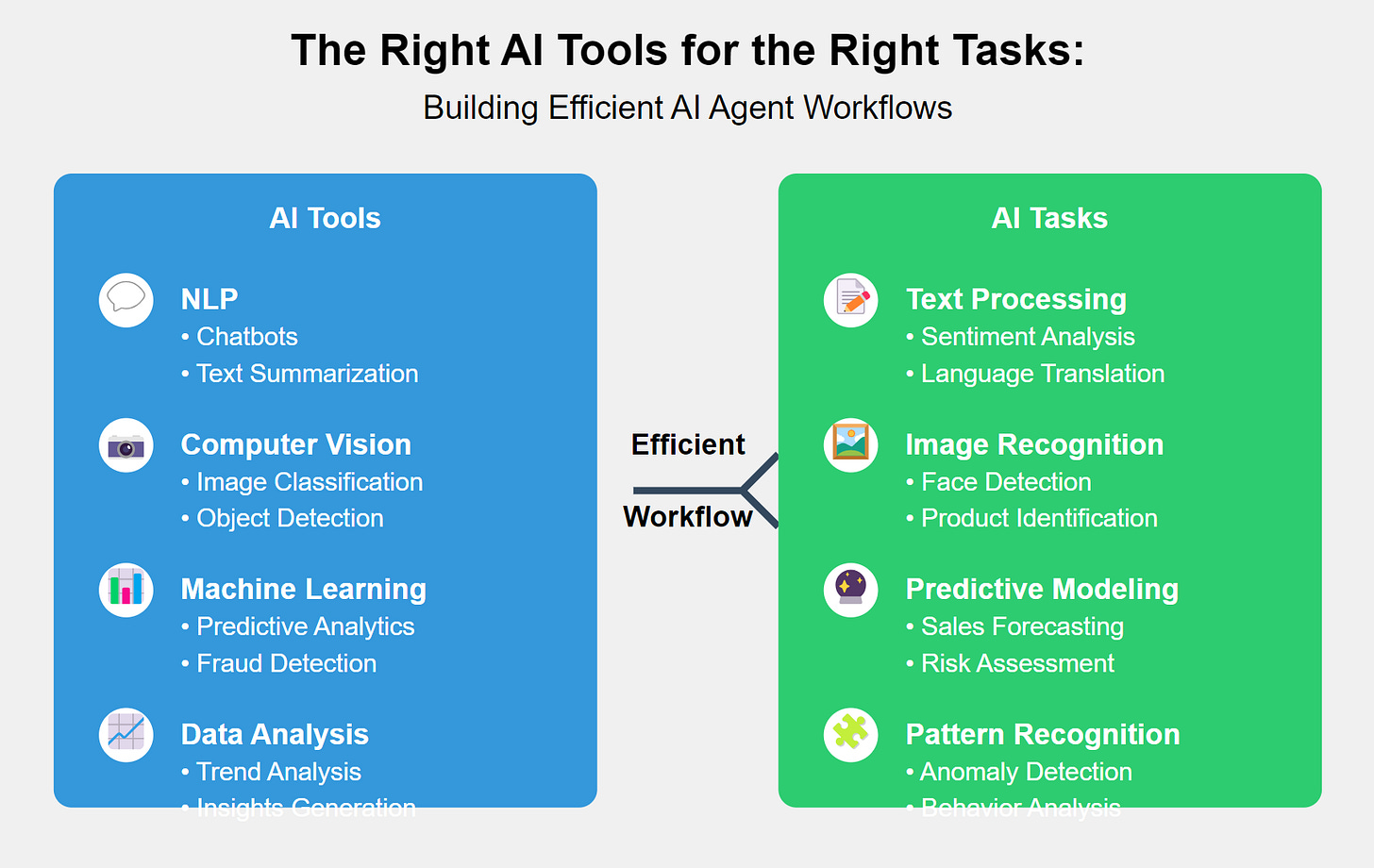Designing Effective AI Agent Workflows: Using the Right Tools for the Right Tasks
Leveraging the Right AI Tools for the Right Tasks to Build Smarter, More Efficient AI Workflows
In AI development, much like in any trade, using the right tool for the job is critical. Imagine trying to frame a house with a sledgehammer. Sure, it’s a powerful tool, but it’s far too heavy and imprecise for the task at hand. Instead, you’d use a claw hammer—perfectly designed to deliver accuracy and control. Similarly, when designing AI agent workflows, we need to select the right Large Language Models (LLMs) and tools for each specific task to create efficient, cost-effective, and powerful solutions.
In this post, we’ll explore how to model AI workflows to ensure the right tools are used for the right jobs—and how this approach leads to smarter, faster, and more effective AI agents.
Why the Right Tool Matters: An AI Workflow Analogy
Every AI agent performs a series of tasks—some simple, others complex. Just as there are different types of hammers for different purposes, there are different AI tools and LLMs that excel at specific types of work.
Using the wrong tool in AI workflows can be as inefficient as using a sledgehammer for delicate carpentry. It might get the job done, but it will be messy, inefficient, and far more resource-intensive than it needs to be. On the other hand, selecting the right model for each granular task can significantly improve efficiency, reduce costs, and deliver better results.
Breaking Down AI Agent Workflows: Selecting the Right Tools
To build an efficient AI agent, start by breaking down its workflow into individual tasks. For each of these tasks, consider the tool or LLM that’s best suited for the job.
Let’s look at a practical example to illustrate:
Task Identification and Segmentation:
Imagine you’re building an AI agent for customer support automation. This task can be divided into:Identifying customer queries
Retrieving relevant information from databases
Formulating a response
Escalating complex issues to human agents
Tool Selection for Each Step:
Simple Queries: Use a fast, lightweight model optimized for answering FAQs. It doesn’t need to be a massive LLM—just fast and accurate for repetitive tasks. This is akin to using a small hammer for precise tasks.
Data Retrieval: When the AI needs to search databases for past transactions or customer data, use a tool optimized for data lookup and retrieval. It’s like picking the ball-peen hammer—precise and focused for a specific job.
Formulating a Response: For more complex responses that require natural language understanding and personalized output, you might use a larger, more robust LLM. Think of this as using a claw hammer—designed for building and shaping with accuracy.
Escalation: When the agent recognizes a query it can’t handle (such as a legal question), it hands off the issue to a human. Alternatively, a domain-specific model fine-tuned for that particular field (finance, healthcare, etc.) could step in.
The Risks of Using the Wrong Tools
Just as using a sledgehammer for framing a house would be wasteful and ineffective, applying the wrong AI model to a task can lead to several issues:
Overcomplication: Using a highly complex model for a simple task results in wasted computational resources, slower response times, and higher costs.
Underperformance: Conversely, applying a small, fast model to a task that requires more nuanced language understanding can lead to inaccuracies or misunderstandings.
Inefficiency: Misaligned tools slow down workflows and drive up costs, leading to suboptimal results and wasted potential.
The Key to Effective AI Agent Design: Granularity and Precision
Efficiency in AI agent design comes from understanding that no single model can do everything well. Just like in carpentry, where you select the right hammer for each task, AI workflows need the best tool for each job. By breaking down tasks into smaller, more manageable components and assigning specialized models to each one, you create a finely tuned process that is both faster and more cost-effective.
Here’s how to do it:
Break Down Tasks: Segment the agent’s work into smaller, granular steps. Each of these steps may require a different tool or model.
Select the Best Model for Each Task: Use simpler models for repetitive, straightforward tasks and more complex models for tasks that require deeper understanding or reasoning.
Continuously Optimize: AI workflows should evolve. Regularly review the models and tools in use, looking for new options that could increase efficiency or accuracy.
Real-World Efficiency: A Scenario
Imagine an AI agent responsible for handling customer queries for an e-commerce platform. When a customer asks about shipping times (a common, simple question), a lightweight LLM quickly provides an answer. But when a customer inquires about a refund for a defective item, a more complex LLM is activated to parse through the customer’s history, find relevant policies, and generate a personalized response. Meanwhile, for issues requiring human intervention, the AI escalates the case directly to an agent—ensuring that only critical cases reach human hands.
By assigning the right tool for each task, this AI workflow is highly efficient, delivering faster, more accurate responses while keeping computational costs in check.
Conclusion: Building Smarter AI Workflows with the Right Tools
Designing effective AI agent workflows isn’t about using the biggest or most powerful models for everything—it’s about using the right tool for the right task. Just like a carpenter wouldn’t frame a house with a sledgehammer, we shouldn’t rely on one model to handle every task in an AI workflow. By breaking tasks down and choosing the appropriate tools, we can build AI agents that are efficient, cost-effective, and highly capable.
So, when building your next AI agent, think carefully about which "hammer" to use—and you’ll create smarter, more efficient workflows that get the job done right.


